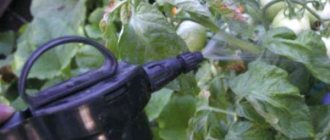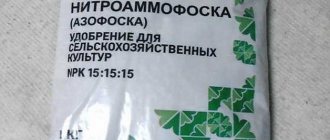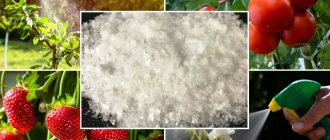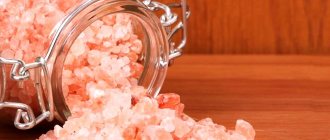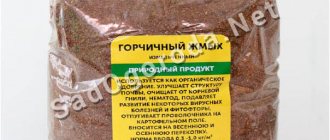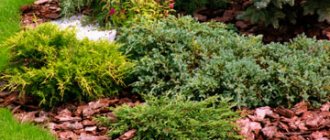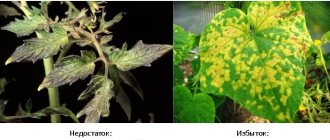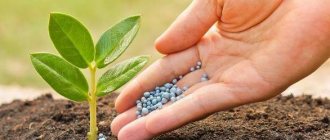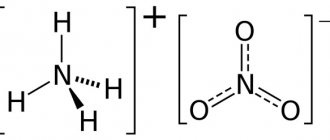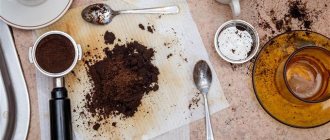For what purposes is manganese used in the garden?
Manganese is used in the garden and vegetable garden in the following areas:
- disinfection of soil, planting material, and garden tools;
- control of certain garden pests;
- protection of crops from infectious diseases;
- fertilizing plants to improve their development.
Potassium permanganate is widely used for household and medical purposes.
Disinfection of seedling containers
Containers and pots for growing seedlings are disinfected with potassium permanganate if they have already been used several times in previous seasons. To do this, the container is rinsed with a one- or two-percent solution of potassium permanganate, and if it is made of wood, then it is left soaked in it for 2-3 hours. Next, the dishes are wiped dry and used for their intended purpose.
Potassium permanganate against pests
The use of manganese to protect plants from pests also gives good results:
- wireworm damaging root crops;
- flies of different types;
- slobbering pennies threatening strawberries.
In the first two cases, you can get rid of pests if, before planting, you spill the soil with a saturated solution of potassium permanganate (5 g of the substance per 10 liters of water), and also soak the seeds and tubers. To destroy the strawberry pest, it is enough to pour hot (about 65º) hot (about 65º) potassium permanganate with a bright pink consistency. Such hot washes carried out in the evening are useful for bushes at any stage of their development. Only for young bushes the temperature should not be higher than 45º.
You can disinfect gardening equipment using such an inexpensive product
Manganese fertilizer: alternative options
If in fact the plants on the site show signs of manganese deficiency, it is better to take a good modern microfertilizer instead of potassium permanganate. For example, one of the following:
| Name | general characteristics | average cost |
| "Microvit Standard" | Liquid fertilizer containing 20 g/l manganese in chelated form. Very easily absorbed by plants. Not phytotoxic. Enriched with other elements important for plants - boron, sulfur, potassium, phosphorus, zinc, copper, etc. | 250 rubles for 250 ml |
| "Microvit K" | Chelated liquid complex microfertilizer containing 31 g/l of chelated manganese. | 670 rubles per 1 liter |
| Manganese chelate | Water soluble powder. Contains about 13% manganese in chelated form, maximally bioavailable through both roots and leaves. | 25 rubles per 10 g |
| "Siliplant Universal" | Liquid chelate fertilizer containing bioactive silicon. It contains 150 mg/l manganese. It is not only a fertilizer, but also a growth stimulator. | 280 rubles per 100 ml |
You can also use the old proven manganese sulfate for feeding. It is less absorbed than chelates and is not suitable for all types of soil, but it is inexpensive and can be used for foliar feeding.
Manganese is part of many complex mineral fertilizers - in particular, the entire line of the popular “Agricola” contains a sufficient amount of this microelement.
Control of plant diseases
Potassium permanganate is also effectively used both for the prevention and treatment of fungal viruses in cultivated plants.
Late blight or late blight
Late blight mainly affects nightshade crops. For preventive purposes, it is recommended to generously spray tomato, pepper, eggplant and potato bushes with a special medicinal solution every two weeks: take 2-3 g of potassium permanganate crystals and a glass of squeezed garlic into a bucket of water. The mixture is left to stand for 3-4 hours, filtered and 2 tablespoons of liquid soap are added to it so that the solution sticks to the plants.
Powdery mildew
Unfortunately, powdery mildew is known to many gardeners and gardeners. It affects strawberries, currants, raspberries, other berry bushes and fruit trees, cucumbers and other melons, as well as flowers. At the first symptoms of the disease, it is necessary to dilute a bright pink solution of manganese and generously spray all affected parts of the plants. Treatment should be carried out 3-4 times every 5 days.
Gray rot
A fungal plant disease such as gray rot most often affects strawberries, grapes, raspberries, cabbage, and onions. To protect crops from this fungus, you can also use sprinkling with a solution of potassium permanganate. In spring, you should use a pale pink mixture (2 g per bucket of water), and before setting fruit, it is recommended to use a more saturated consistency (1 g of substance per liter of water).
To prevent plants, it is effective to use a solution of potassium salt
Blackleg
A solution of potassium salt of permanganic acid can also actively fight blackleg, a disease that often affects vegetable seedlings, and sometimes adult tomato bushes, cabbage, and flowers. For prevention, it is recommended to water the seedlings at the root with a slightly pink mixture of potassium permanganate. When a disease appears, the damaged plant must be removed along with a layer of soil, add ash or sand and generously spill the soil with a saturated solution of potassium permanganate.
Disinfection of working tools
Gardening tools that summer residents often use (secateurs, saws, scissors) require periodic disinfection, and potassium permanganate is ideally suited for these purposes. It is diluted until it turns dark red, work equipment is placed in it and left for 20-30 minutes. Every gardener can prepare a simple, accessible and inexpensive remedy.
Related article:
Carefully! 7 poisonous plants in the garden that you need to watch out for
Use as a top dressing
Permanganic acid is also recommended for use as a feed for crops lacking magnesium and potassium. Feeding plants with manganese stimulates the development of the root system, the production of necessary sugars and acids, and the setting and ripening of fruits. It plays an important role in photosynthesis and respiration of plants, and improves their immunity.
The main thing to remember is that you should not overdo it with fertilizers, since an excess of manganese in plants will damage them no less than its deficiency. In addition, it is necessary to strictly observe the proportions when preparing the solution, since a stronger concentrate will lead to burns and death of crops.
It is recommended to use permanganic acid as a feed for crops.
Main symptoms of manganese deficiency
Manganese deficiency in plants manifests itself in the following signs that you need to pay attention to:
- yellowing of leaves between the veins and at their base;
- the appearance of yellow spots and dots on the leaves, which over time turn into light yellow necrotic spots;
- leaf dying.
Sugar beet roots
For the development of sugar beet roots, foliar fertilizing with a solution of potassium permanganate has a good effect. They can be carried out several times a season by watering the tops or spraying. The mixture is prepared at the rate of 5 g of substance crystals per bucket of water (10 l).
Potato
In mid-summer, it is effective to feed potatoes with a solution of potassium salt of permanganic acid. To do this, dissolve 3 g of crystalline powder in 10 liters of water.
Cabbage
Cabbage also responds well to fertilizing with manganese. Watering with a solution made at the rate of 3 g of potassium permanganate crystals per bucket of water is best done in July. This amount is enough for use on 4 m2 of plantings.
It is effective to feed potatoes with a solution of potassium salt in mid-summer
Blue eggplants
Do you use folk signs in gardening?
Feeding blue eggplants with a weak solution of potassium permanganate, prepared in the proportion of 2-3 g of crystals per bucket of water, is useful. It is better to carry them out in mid-summer by spraying the bush.
Silage corn
In July, you can feed silage corn with a non-concentrated solution of potassium permanganate, which will improve the quality of the silage and accelerate the ripening of the cobs.
Fruit and berry plants
To feed raspberries, strawberries, currants, gooseberries, and rose hips, use a light solution of potassium permanganate (2-3 g per bucket of water), to which add a glass of sifted ash. It is better to spray shrubs with this mixture before buds appear on them.
Grape
It is recommended to foliar feed grapes with a nutrient solution: dissolve 3 g of potassium permanganate and 3 g of boric acid in a bucket of water.
Fertilizing tomatoes with potassium permanganate
Tomatoes are fed with a fairly light solution of potassium permanganate (2 g of the substance per 10 liters of water). The first time feeding tomatoes is carried out at the stage of 3-week seedlings either by spraying on the leaf or by watering under the bush. The next feeding is best done by spraying the tomatoes on the eve of flowering to stimulate fruiting.
Tomatoes are fed with a light solution of potassium permanganate.
Is it possible to water cucumbers with potassium permanganate?
Fertilizing cucumbers with a mixture of potassium permanganate leads to an increase in the number of ovaries. It is best to carry it out during the period of active fruiting of the vegetable, using an unsaturated nutrient solution (2 g of crystals per 10 liters of water).
Precautionary measures
Potassium permanganate is a chemical that can cause trouble if stored and used incorrectly. Therefore, follow the safety rules.
- Store the substance in a dark, cool place out of the reach of children;
- Do not handle crystals with bare hands; work with rubber gloves;
- Dissolve in warm water, this will dissolve the grains faster, stir until completely dissolved;
- Prepare the solution for single use; the prepared solution cannot be stored for long periods of time;
When mixed with organic substances (glycerin, tannins, sucrose, etc.), easily oxidized substances, self-heating occurs. Sometimes this leads to spontaneous combustion and explosion.
Have a good harvest!
Using manganese solution for indoor plants
Just as for garden or vegetable crops, the role of manganese for indoor plants is its disinfecting effect and replenishing the lack of microelements necessary for the growth and development of plants. To obtain benefits from the drug, it is necessary to use potassium permanganate only within acceptable limits, otherwise it can cause plant burns and excessive oxidation of the soil.
Manganese solution is also used for indoor plants
What flowers can be watered
Acidic soil is not suitable for all types of plants, so they respond favorably to the use of a solution of potassium permanganate. This product is perfect for indoor plants such as:
- fern;
- ivy;
- orchid;
- hydrangea;
- begonia;
- monstera;
- violet.
How to dilute the product
In various areas it is necessary to use solutions of potassium permanganate of different concentrations:
- For spraying, use a very weak solution - almost transparent with a slight pale pink tint. To obtain it, dissolve 1 g of crystals in 5 liters of water.
- To feed indoor plants, a solution of a more saturated light pink color is used, which is achieved by dissolving 1.5 g of potassium permanganate in 5 liters of water.
- To disinfect soil in pots, prepare a more saturated solution: 0.5 g of product per 1 liter of water.
- To soak the seeds, 1 g of the drug is dissolved in 500 ml of water.
To get the desired effect from use, you should take a fresh ready-made solution, which has been stored for no more than 3 or 4 days.
Dosage and frequency of watering
For prevention, it is enough to water indoor plants twice a year. And to combat pests or diseases, more frequent watering is allowed, but not more than once every 7-10 days. It is better to supplement them with exposure to other substances - ash, tobacco or laundry soap. More frequent watering can cause deterioration in the condition of plants due to an excess of manganese and potassium.
How to use potassium permanganate
The range of uses of potassium permanganate is quite diverse.
Seed dressing
If before sowing the seeds are soaked in slightly pink potassium permanganate, this will not only disinfect and destroy pathogens, but also provide the seeds with a starting reserve of strength that promotes plant growth. The result is rich and environmentally friendly products.
The seeds are soaked for 15-20 minutes; there is no need to keep them longer to avoid burns on the shell. After soaking, the seeds are washed and then dried at room temperature. Seeds are treated not only before planting, but also before long-term storage.
Processing of planting material
Onions, garlic, bulbs of decorative flowers (tulips, gladioli, lilies, etc.), potatoes are also treated in a weak solution before planting. But know that the treatment procedure saves the plant only at the initial stage of growth. In the future, we will have to use other methods of combating diseases.
Processing seedling boxes
Before sowing seeds for seedlings, the boxes must be treated with a strong solution. It is possible that bacteria remained on the box after previous use. The boxes are completely submerged in a large container, then rinsed. Or use a rag soaked in potassium permanganate to wipe the inside surface of the drawers. Don't forget to wear rubber gloves!
Tillage
To enhance the effect, heat the water to 60-70ºС, add potassium permanganate to obtain a dark pink solution. In this way, they get rid of pathogens that cause late blight, black leg, gray rot, and powdery mildew. Plant seeds only in cooled, dried soil. Moreover, the following concentrations are used:
- weak – with black leg and late blight,
- medium – for powdery mildew,
- strong – with gray rot and mosaic disease.
The soil near the greenhouse is treated with a medium pink solution to destroy pathogens of vegetables and pests.
Greenhouse treatment
A medium pink solution is used to wash the polycarbonate inside the greenhouse before preparing for winter. After spraying the interior walls, they are then washed with clean water.
Processing garden tools
Tools (shovels, pruners, flat cutters, etc.) must be treated with a dark solution so that the disease does not spread further with the juice of the affected plants.
Plant nutrition
Since the composition contains potassium and manganese, plants are fed with potassium permanganate simultaneously with soil cultivation. A lack of potassium in the soil is rare, especially since gardeners use wood ash, rich in potassium, as a top dressing. But manganese is a microelement that is sometimes lacking in the soil. Its deficiency reduces the plant's defenses, productivity, and slows down the ripening of fruits. For fertilizing, use a weak solution; one fertilizing in the spring is enough.
Some summer residents prefer to use potassium permanganate together with iodine and boric acid. But experienced gardeners do not recommend doing this, considering such use ineffective and harmful.
Potassium permanganate for indoor plants
Frequently abundant watering of indoor plants leads to the appearance of fruit flies. Midge larvae feed on the sap of the roots, and the plant gradually dies. Potassium permanganate helps to cope with them; just water the soil in the pot with a weak solution.
